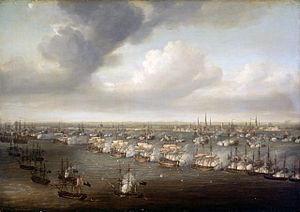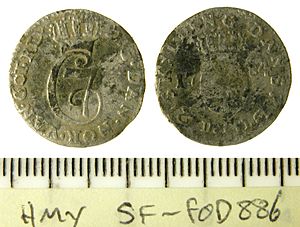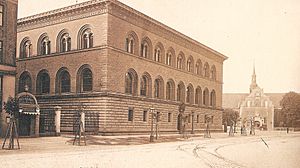Danish state bankruptcy of 1813 facts for kids

Frederik VI, King of Denmark, 1809
|
|
| Date | 5 January 1813 |
|---|---|
| Type | State Bankruptcy |
| Cause |
|
| Outcome |
|
The Danish state bankruptcy of 1813 was a big money problem that hit Denmark in January 1813. It caused trouble for several years, until 1818. At this time, Denmark-Norway was struggling with the huge costs of the Napoleonic Wars. The value of their money dropped a lot, which was bad news for everyone, including businesses and regular people.
Denmark-Norway joined forces with France in 1807 after British attacks on Copenhagen. This alliance meant they had to spend a lot of money on weapons and supplies for the war. Soon, the country couldn't afford these costs, and its money started to lose value very quickly. King Frederik VI of Denmark-Norway stayed loyal to Napoleon and France, which ended up costing Denmark a lot.
In January 1814, the Treaty of Kiel was signed. This agreement made Denmark much weaker in Europe. King Frederik VI had to give up Norway to the king of Sweden. This made things even harder for Denmark's trade and its already weak economy.
Because of the Napoleonic Wars, Denmark-Norway had to declare bankruptcy on January 5, 1813. The government had two main goals: to fix the economy and create a single money system for the whole country. The Rigsbank was the first bank created to help fix the economy by changing the money system. Later, in 1818, the Nationalbank was set up. This private bank helped people and businesses get loans, aiming to bring back silver as the main money and make people trust the banking system again.
Contents
How Did Denmark Go Bankrupt?
What Were the Napoleonic Wars?
Denmark-Norway tried to stay out of the early parts of the Napoleonic Wars. But both Russia and France were interested in Denmark-Norway's navy and its important trade routes through Norway. The British knew they needed to control these sea routes. So, in September 1807, the British attacked Copenhagen, Denmark's capital. They wanted to capture or destroy Denmark-Norway's ships.
After the attack, Britain controlled key sea lanes in the Baltic and North Seas. King Frederik VI and his government believed that keeping Norway was vital for Denmark's power in Europe. They also worried about Norway's food supply and the chance of a French invasion. These fears led them to ally with Napoleon.
Denmark-Norway didn't have much to offer France after losing its navy. The cost of rebuilding their military and preparing for war put a huge strain on Denmark-Norway's economy. Even after the attack on Copenhagen in 1807, King Frederik VI stayed loyal to Napoleon and France. This was even after Sweden and Russia switched sides to join Great Britain.
When France attacked Russia in 1812, both Russia and Sweden teamed up with Great Britain. This left Denmark-Norway as one of France's few remaining allies. After many defeats between 1810 and 1812, King Frederik VI became very worried about losing Norway and his lands in northern Germany.
When Was Bankruptcy Declared?
On January 5, 1813, Denmark-Norway officially declared bankruptcy. A new state bank, the Rigsbank, was created to help the economy recover. The Rigsbank's main job was to fix and stabilize the country's money system.
When Denmark-Norway allied with France in 1807, they signed the Treaty of Fontainebleau. France promised Denmark-Norway loans and money to cover their war costs. However, France didn't keep its promises. Denmark-Norway ended up paying for the French army's actions in Denmark in 1808. Also, the promise to send troops and equipment to Napoleon throughout the war only added to Denmark-Norway's expenses.
What Was the Treaty of Kiel?
The Treaty of Kiel was an important document signed in January 1814. It involved Denmark-Norway, Sweden, and the United Kingdom, and it marked the end of the Napoleonic Wars for Denmark. Sweden and the United Kingdom were allies against Denmark and Norway, who were allied with France.
Because Denmark lost the war, the Treaty of Kiel forced them to give up Heligoland to the United Kingdom. King Frederik VI of Denmark also had to give up his rule over Norway to King Charles XIII of Sweden. This was a big disappointment for King Frederik VI.
However, under Article III of the treaty, Denmark was able to keep control of Greenland, Iceland, and the Faroe Islands. Losing so much land, the end of its union with Norway, and the shame of defeat had serious economic and social effects on Denmark.
Why Did Denmark's Economy Collapse?
Internal Problems
The high cost of war efforts greatly damaged the Danish economy. To pay for new weapons and supplies, the Danish government printed a huge amount of banknotes. The country's money was supposed to be based on silver. But printing too many banknotes made silver lose its value.
The Danish government couldn't pay back loans from its own people. So, they printed even more money to cover war spending. Denmark's efforts to prepare for war economically led to its money becoming almost worthless.

King Frederik VI's choice to stay loyal to Napoleon and France in 1812 was a major reason for Denmark losing power. As France and its allies were defeated, Denmark had to give Norway to Sweden. It also lost important lands in North Germany. This put even more pressure on Denmark's money. It not only harmed the economy but also led to poverty and a worse quality of life for many citizens.
External Pressures
Britain's attack on Copenhagen in September 1807 ended Denmark's neutral stance in the Napoleonic War. Denmark was forced to ally with France, even though its navy was destroyed and it had little military power left. Britain then stopped all trade with Denmark. This, combined with the loss of Denmark's navy, meant trade between Denmark and its colony, Norway, almost completely stopped.
The alliance between Denmark and France was a key reason why Norway was lost to Sweden in the Treaty of Kiel. Norway's economy was more connected with Great Britain's. When trade between Denmark and Norway stopped due to the blockade, Norway started trading with Great Britain instead. Joining the war and facing a trade ban meant Denmark had huge financial burdens to prepare for battle, especially after losing control of vital sea lanes.
What Were the Effects of Bankruptcy?
Economic Impact
King Frederik VI decided to stop all trade with Britain after the Copenhagen attack. This badly hurt Denmark's import and export businesses. For example, the Danish timber market, which relied on trade with other European countries, saw a 99% drop in sales from 1806 to 1808.
Between 1808 and 1813, prices kept rising. In 1813 alone, prices went up by about 300 percent! The government lost faith in its own money. Some taxes even had to be paid with grain instead of banknotes. The Treaty of Kiel and the loss of land caused problems with how banknotes circulated. Even though Denmark's population shrank, the amount of money in circulation didn't. This made inflation even worse. Because of the war, Denmark had to stop paying its foreign debts and interest until 1815.
Political Choices
Before France was defeated by Russia in 1812, Denmark was offered a chance to switch sides and join Britain and its allies. This would have lessened the problems Denmark faced after the war. It also might have allowed Denmark to keep lands it had already gained.
Some historians, like Michael Bregnsbo, suggest that King Frederik VI stayed loyal to Napoleon because he believed Napoleon would lead the peace talks if France won. Another historian, Morten Ottosen, argues that King Frederik VI's stubborn loyalty to Napoleon was a mistake and led to future failures for Denmark.
Social Challenges
The British blockade on Norway and Denmark affected everyone. Stopping trade meant fewer jobs, as goods weren't being made and money wasn't flowing. In response to the Copenhagen attack, King Frederik VI banned all trade and communication with Great Britain in 1807. However, merchants and citizens knew they needed British goods, which became very valuable.
Corruption became common as inflation and lower wages hurt the population. Government workers were often tried for corruption, especially for stealing money. The king's trusted officials betraying him put pressure on the monarchy. They needed to show the public that their absolute rule was strong to stop ideas about democracy from spreading.
How Did Denmark Recover Economically?
The Rigsbanken's Role
On January 5, 1813, a new law called the "Decree on changing the currency system for the Kingdoms of Denmark and Norway and the duchies of Schleswig and Holstein” was announced. The Minister for Finance, Ernst Schimmelmann, declared:
“Since the government’s existing currency system is shaken to the core, we have decided to bring order and stability to the system by establishing a permanent and unshakeable foundation for it".
The economy began to recover with the creation of the Rigsbanken. This bank was allowed to print new banknotes in a new currency, the rigsbankdaler. People had to pay a required 6% mortgage rate in silver. There was also a 6.5% interest rate on all real estate. The government asked for donations of silver or money as loans to help the new Rigsbanken. This immediate money helped the Rigsbank get started. Old banknotes from the Napoleonic Wars could be exchanged for the new currency at a rate of 6 old notes for 1 new one. This was a huge drop in value. The goal was to stop printing new notes until silver and banknotes had the same value.
The Nationalbanken's Creation in 1818
On July 4, 1818, King Frederik VI created Denmarks Nationalbank. This bank was given the power to be the country's central bank. Its rules were signed, giving it the sole right to print banknotes for the country. It was set up to be independent from the government. This was to assure the Danish people that the government wouldn't print too much money again in the future.
The Nationalbank cut the number of banknotes in circulation by half between 1818 and 1838. By 1838, silver and banknotes were worth the same again. The Nationalbank's success is still remembered today. It is now Denmark's central bank and is credited with bringing back financial trust to the country.
How Did Denmark's Economy Become Stable Again?
The hard work of the Nationalbank and the Rigsbanken eventually made the economy stable. During the time of bankruptcy, primary education for children aged seven to fourteen became required. This was an effort to reduce the gap between rich and poor citizens, as everyone was affected by the crisis. By 1838, the amount of banknotes in circulation and the value of silver were equal. This meant that debt payments could start again, and the economy began to return to its former strength. By reducing the number of notes, the Nationalbank made it possible to exchange silver for banknotes by 1845.




